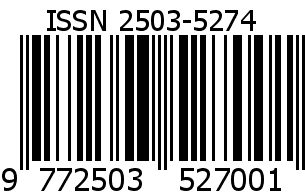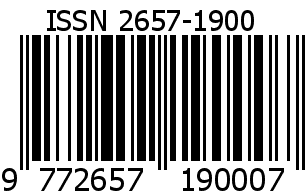VISUALISASI FENOMENA HARMONIS DAN CHAOS PADA GETARAN TERGANDENG BERBASIS KOMPUTASI NUMERIK RUNGE KUTTA
VISUALIZATION OF HARMONIC AND CHAOS PHENOMENA IN COLLECTED VIBRATION BASED ON NUMERICAL COMPUTATION RUNGE KUTTA
Abstract
Research has been carried out on the visualization of harmonic and chaos phenomenont on coupled vibration physcal case using the Runge Kutta numerical computation method with the aim of applying the first to fourth order Runge Kutta computation method to obtain a second order differential equation solution on coupled vibration system, calculating the displacement value of objects using computation method Runge Kutta order first to fourth, obtained a graph of the displacement of objects againts time in case of coupled vibration for harmonic and chaos states at certain step width values and compare the convergence of the Runge Kutta method from first to fourth order with the special analytical method. The solution of coupled vibration equation which is classified as a second order differential equation was quite difficulted to solve analytically, so the Runge Kutta computation method was used to solve it as an alternative solution. The results of the research showed that the harmonic state of the system was obtained when the displacement graph showed the motion of each pendulum which was constant with the pendulum displacement position with respect to time in the form of a sinusoidal graph at a value of C1 = 40 N/m, C2 = 30 N/m, C = 10 N/m, C = 0 N/m and the chaotic state was represented by a graph of the displacement of the pendulum with respect to time with an irregular pattern. In this case, it was found that the fourth order Runge Kutta method converged faster than the first to third order Runge Kutta method with the best results obtained at a step width value of 0,001. The fourth order Runge Kutta method also has a smaller approximation average error value from first to third order Runge Kutta method was on the fourth order Runge Kutta method and the avarage error values are , and on the Runge Kutta method of first to third order.
Downloads
References
2 Dewanto, J. 1999. Klasifikasi Getaran. Jurnal Teknik Mesin. Vol. 1, No. 2, hal 156-162
3 Tungga, BK. 2011. Dasar-dasar Getaran Mekanis. Yogyakarta : Penerbit Andi
4 Warsito, A. 2009. Fisika Komputasi. Modul Bahan Ajar Fisika FST Undana
5 Schmid, Erich W, dkk.1990. Theoretical Physics on Personal Computer 2th Edition.New York: Heidelberg
6 Arafah, E. 2002. Coupled Harmonic Oscillations. Department of Physics. University of Jordan
7 Sulaiman, Halfiana. 2008.Kajian Fenomena Fisis Getaran Selaras Tergandeng dengan Metode Euler dan Runge-Kutta. Skripsi Jurusan Fisika-FST : Universitas Nusa Cendana
8 Halliday, Jearl. W, dkk. 1998. Fundamental of Physics 9th Edition. USA : John Wiley & Sons, Inc
9 Tipler, P.A. 1991.Fisika Untuk Sains dan Teknik. Jakarta : Erlangga
10 Chapra, S.C., R.P. Canale. 2014. Numerical Methods for Engineers 7th Edition. McGraw-Hill Education : New York
11 Giancolli, Douglas C. 1997. Fisika Jilid I Edisi Keempat. Terjemahan Cuk Imawan, dkk. Jakarta : Erlangga
12 Boas, M.L. 1983. Mathematical Methods in the Physical Sciences 3rd Edition. USA: John Wiley & Sons, Inc
13 Beiser, Arthur. 1981. Konsep Fisika Modern. Jakarta : Erlangga
Jl. Adisucipto, Penfui-Kupang, Lasiana, Klp. Lima, Kota Kupang, Nusa Tenggara Timur., Indonesia
This work is licensed under Attribution-NonCommercial-ShareAlike 4.0 International (CC BY-NC-SA 4.0)
 Leonora L. R. Trifina(1*)
Leonora L. R. Trifina(1*)
















